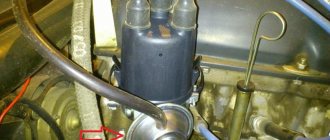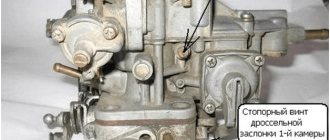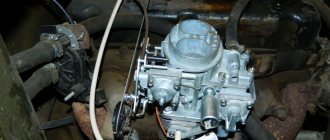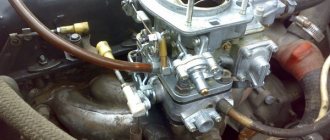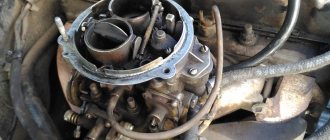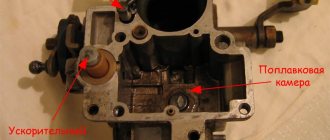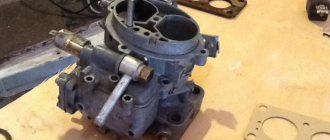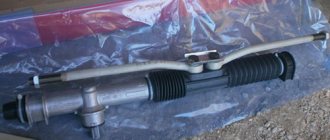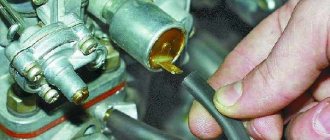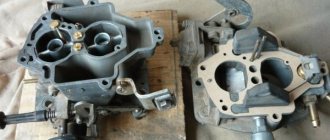Published:
26.05.2016
Unfortunately, no car is without flaws, be it a foreign car or a domestic model. But if defects in foreign cars are extremely rare, and even less often the design itself allows them to interfere, then Russian cars are simply created for this. The best choice is the classic AvtoVAZ model, where you can experiment from the heart. But most often you have to do this out of necessity.
Introduction
Any car makes its owner happy until any troubles begin to happen to it.
Naturally, such circumstances upset every driver. If the car is not new, then the repair costs may be too high, and it is very difficult to resolve the issue on your own. However, real VAZ connoisseurs are trying to study their iron horse inside and out and carry out repair work themselves. This primarily concerns the repair of important components; many are interested in installing a Solex 21083 carburetor on a VAZ-2107. The most popular carburetor for the VAZ-2107 is Solex
Since the release of VAZ cars with carburetor engines, parts from the following manufacturers have been installed on them: Ozone, Solex, Weber. But Solex carburetors were and continue to be the most popular. Let's look at the adjustment and tuning of the carburetor of this brand in a little more detail.
Engine tuning
We boost the classic engine to 150 hp.
Although the classic engines are outdated, they can also be used to build quite powerful units.
In some ways, their simplicity and lack of electronics is even a plus. you can do a lot yourself. And the costs for electronic gadgets may clearly be higher. It’s not for nothing that in America they still build hot rods with carburetors. This material is mostly theoretical in nature because the result obtained largely depends on your efforts, skills, time, etc. If you don’t rush anywhere and do everything carefully, you can “turn up” the engine to 150 hp.
Installing two carburetors
Two carburetors on the VAZ 2107 will give the car additional power. In addition, fuel consumption will be significantly reduced, which is very important for any driver today.
The procedure for installing two carburetors at once is advisable in the following cases:
- it is necessary to increase the speed characteristics of the car;
- Fuel economy required;
- we need to work out the emissions system and make them more environmentally friendly;
- The car lacks dynamics when overtaking, starting from a standstill or accelerating.
Video: two Solex carburetors on a VAZ car
At the moment, VAZ 2107 cars are very actively used in Russia. Models equipped with carburetors have excellent performance characteristics and are quickly and cheaply serviced and repaired. For the convenience of the driver, carburetors of various types and brands can be installed on the “seven”. However, before installation, you need to calculate the feasibility of such work and guarantee the expected result.
Preparing to modernize the engine power system
Connecting the carburetor to the manifold is not done on the car. This type of work is carried out in good lighting. Having connected the carburetors one by one to the intake manifolds of the Oka, you need to open both chambers and check the condition of the joint. It is strictly forbidden to allow the edges of the collector to protrude above the joint. The air-fuel mixture will swirl at the junction at high speed and the engine will starve.
Fitting intake manifolds
To eliminate protruding edges, use a metal cutter inserted into a screwdriver or drill. The transition between parts should be as smooth as possible. For better results, you can use sandpaper or special sanding pastes.
Installation of a polished engine power system
During a visual inspection, it is possible to detect sagging and casting defects in both the carburetor and the manifold. A car owner who independently installed and tuned the fuel system knows about the need for modifications, but a newbie may be surprised by the protruding pins inside the manifold. This creates strong resistance to air flow, which significantly reduces the effect of installing two carburetors.
Features of the installation DAAZ-2108, -21083
To install any of these models on the “Classic”, it is necessary to prepare a new set of gaskets, hoses for the carburetor heating system, a tee for connecting to the fuel system, a valve and rods for the accelerator. To get the maximum result from this procedure, it is advisable to replace the ignition. It is better to install a more technologically advanced, electronic one. Contact ignition is a thing of the past. The system is very unreliable and often causes operational problems. The installation of contactless electronic ignition is one of the most useful improvements for domestic VAZs, in particular for the Six.
Installing two carburetors
Two carburetors on the VAZ 2107 will give the car additional power. In addition, fuel consumption will be significantly reduced, which is very important for any driver today.
The procedure for installing two carburetors at once is advisable in the following cases:
- it is necessary to increase the speed characteristics of the car;
- Fuel economy required;
- we need to work out the emissions system and make them more environmentally friendly;
- The car lacks dynamics when overtaking, starting from a standstill or accelerating.
Contrary to prejudices, installing a second carburetor does not increase fuel consumption, but, on the contrary, reduces it
How to adjust a Solex carburetor
Only a properly adjusted carburetor can ensure maximum engine performance and efficiency. For the most accurate adjustment, experts recommend installing the car on a level surface - this promotes better preparation of the air-fuel mixture. First, start the engine and test its operation at different speeds. This way, you can determine in which mode the normal mixture is prepared, and in which adjustment is required.
The following guide will tell you how to set up a Solex carburetor on a VAZ-2106:
- Once you have started the engine, let it run to warm up to operating temperature.
- During warm-up, the float chambers will fill with fuel, which will allow you to check its level. To do this, you need to remove the cover from the carburetor and measure the distance between the upper edge of the float chamber and the level of gasoline in it. Use a caliper. The recommended level at which the spark plugs will not flood and the engine will not stall at idle is 23–25 mm. If the obtained values do not correspond to the norm, you will have to adjust the carburetor regarding the fuel level.
- Adjustment of the gasoline level in the float chambers is carried out by bending/bending the float up or down.
- Once the setup and control measurements are complete, replace the cover and proceed to the next step.
- Next, adjusting the Solex carburetor on the VAZ-2106 consists of adjusting the idle system. If you purchased a new unit for installation, then the optimal settings for preparing a combustible mixture at idle speed are as follows:
- The mixture quantity screw must be unscrewed 1.5–2 turns;
- The mixture quality screw should be unscrewed 4–4.5 turns.
This concludes the guide on how to adjust the Solex carburetor on a VAZ-2106 after installing it. However, in conclusion, it should be said that the “sixth” model with this unit will inherit both important advantages and noticeable disadvantages. The first includes improved engine response and a top speed increased to 165 km/h. The modernization also has a positive effect on acceleration - the car will be able to reach the first 100 km/h two seconds faster. As for the disadvantages, there are only two of them - increased fuel consumption and increased requirements for the quality of gasoline use. In general, by installing a Solex carburetor on a VAZ-2106 with your own hands, you will get more comfortable driving, the cost of which is not so high.
The unification of spare parts and vehicle components during the Soviet period made it possible to install various parts instead of standard spare parts. The same fate awaited the option of installing a Solex carburetor on the VAZ 2106, although here it is necessary to take into account some design features of the product. In terms of mounting, such a device fits perfectly into the standard place of the “six” for the carburetor.
Read more: Overfilling the carburetor on a motorcycle
Engine starting
The engine needs to be sufficiently warmed up after the first start. By the way, it may not be possible to start right away and this is quite normal. Next, you should adjust the motor. You can turn to specialists or even bikers who have extensive experience in regulating multi-carburetor motorcycles using a vacuum gauge plate. It is possible to make such a thing yourself from econometers, although they have a very high error and require calibration. The quality sensor is placed in place of the spark plug and the color is checked - there should be a blue mixture at idle. The color should be like this everywhere - in the first, in the second, in the third, in the fourth. All that remains is to set the required speed using the quality screw, and that’s it. The suction is very easy to adjust, although in the summer it already works fine.
Do-it-yourself carburetor adjustment
Thanks to the simplicity of the Ozone design, making the necessary adjustments yourself will not cause any difficulties. It is only necessary to properly prepare for adjustment work and carefully follow all requirements and instructions.
Preparatory stage
To make the adjustment quick and efficient, you will need to spend a little time and carefully consider all the nuances of the work. First, you need to prepare a comfortable place for yourself, that is, make sure that nothing or no one will interfere with your work, and that there is enough light and air in the room.
The carburetor should only be adjusted when the engine is cool, otherwise personal injury may occur. It doesn’t hurt to stock up on rags or rags in advance, since some fuel leaks are inevitable during adjustment.
It is important to prepare the necessary tools in advance:
- set of wrenches;
- a Phillips-blade screwdriver;
- a flat blade screwdriver;
- round probe;
- school ruler for measuring distances between nodes.
It is also recommended that you read the information provided in the vehicle’s service book. This document contains individual parameters and recommendations for setting up and adjusting the operation of the carburetor.
Adjustment of quality and quantity screws
Most problems with Ozone can be solved by simply adjusting the quantity and quality screws. This is the name given to small devices on the carburetor body that correct the operation of the main components of the device.
With the help of quality and quantity screws, most carburetor malfunctions can be eliminated
The procedure takes a little time and is carried out only with the engine completely cooled but turned on:
- Turn the quality screw to maximum, turning it counterclockwise until it stops.
- Set the quantity screw to an even higher number of revolutions - for example, 800 rpm, turning the screw itself counterclockwise.
- Check with the quality screw whether the maximum position for the screw has actually been achieved, that is, turn it half a turn back and forth. If the maximum performance was not achieved the first time, then the settings specified in paragraphs 1 and 2 must be carried out again.
- With the fuel quantity screw set to its maximum settings, you need to turn the quality screw back so that the speed drops to approximately 850–900 rpm.
- If the adjustment is carried out correctly, then in this way it will be possible to achieve optimal carburetor performance in all respects.
Float chamber - making adjustments
Correcting the position of the float in the chamber is necessary for the normal functioning of the carburetor in all operating modes. To work, you will need to make sure that the motor is cool and does not pose a danger to humans. After this you need:
- Remove the cap from the carburetor and place it vertically so that the gasoline supply fitting points upward. In this case, the float itself should hang down, barely touching the needle. If the float is not perpendicular to the valve axis, you will need to straighten it with your hands or pliers. Then return the carburetor cover to its place.
- Use a ruler to measure from the carburetor cap to the float. The optimal indicator is 6–7 mm. If this is not the case, you will need to bend the float tongue in the desired direction.
- Raise the Ozone lid again strictly vertically.
- Move the float as far as possible from the center of the float chamber. The distance between the float and the cover gasket should not be more than 15 mm. If necessary, you need to bend or bend the tongue.
Adjusting the opening of the second chamber
The throttle valve is responsible for the timely opening of the second chamber of the carburetor. Adjusting this unit is as simple as possible:
- Tighten the damper mounting screws.
- Make sure that the device is pressed tightly against the chamber wall.
- If necessary, replace the sealing elements.
Video: general overview of adjustment work
The Ozone carburetor was developed specifically for rear-wheel drive VAZ 2107 models. This mechanism made it possible to create an economical and fast car of the new generation of the Volzhsky Automobile Plant. The main advantage of Ozone is its simplicity of operation cycles and ease of maintenance. However, if you have doubts about the ability to independently adjust the Ozone units, it is better to seek help from specialists.
NIVA CARBURETOR: WE SET UP AND REPAIR YOURSELF
The carburetor on models 2121, 21213 and other cars has basically the same device. Functionally, it is located in the propulsion system, and with its help the fuel is mixed to the state of a combustible mixture. A carburetor, as a rule, consists of several main elements - a float chamber, a so-called jet (with a spray), a diffuser, and a throttle valve. It can have from one to four cameras on different cars, sequential or simultaneous opening of the throttle valves, horizontal, downward or upward movement of the working mixture.
Elements of the carburetor on Niva models
The carburetor circuit also includes: a drive lever from the accelerator pump, a diaphragm, an adjusting screw and an air duct from the starter, a shut-off valve (solenoid), an air damper, a needle valve, a fuel supply fitting, an economizer for power modes, a carburetor heating unit, fittings for crankcase ventilation, for supplying vacuum for the vacuum regulator in the ignition, and other elements.
Niva 2121 has the following sequence of passage of fuel elements through the carburetor chamber. First, fuel moves from the fuel tank to the float chamber in a controlled amount. The float rises or falls as the fuel moves.
Further, the fuel path lies through the nozzle into the atomizer, located in the narrow part of the diffuser, with simultaneous air entering the carburetor through the outer pipe. The throttle valves then deliver varying amounts of fuel into the engine cylinder through an intake manifold cast from aluminum alloys. The manifold is attached to the engine with studs through gaskets that have heat-resistant properties.
"Solex" and "Ozone"
The VAZ 2121 Niva model can be equipped with an “Ozone” carburetor with the serial designation 2107-110-7010-10 or 2107-110-7010-20. They differ from each other in that the first option has an old-style breaker and does not have a vacuum corrector. The second carburetor does not have a microswitch from the economizer, which affects the environmental friendliness of emissions and has some impact on fuel consumption.
The Niva 21213 is equipped with Solex type carburetors (model 21073-110-7010). They are considered quite “capricious”, which is primarily due to the negligence of the owners themselves. The incorrect operation of the device is primarily affected by low-quality fuel with a large amount of impurities, since in this model the fuel is taken through holes in the bottom of the float chambers (in other models these elements are raised above the bottom).
In addition, problems arise for those “nivovods” who do not promptly change the fuel or air filter, and also do not pay attention to proper cleaning of the carburetor from oil soot emissions through the ventilation system. Adjustment of the VAZ carburetor is usually carried out in the float mechanism or in the starting and idle systems
These are very important operations that are best left to the experts.
Adjustment of the VAZ carburetor is usually carried out in the float mechanism or in the starting and idle systems. These are very important operations that are best left to the experts.
The float mechanism on the Niva 2121 is adjusted in terms of the position of the floats relative to each other and relative to the walls of the float chamber. In addition, the mechanisms in the open and closed positions of the needle valve may need to be adjusted. In order not to disturb good adjustment, the car owner needs to carefully handle the carburetor cover when removing it, monitor the level of wear of the shut-off cone from the needle (its seat and tongue), as well as the axis of the mounting bracket.
We carry out the adjustment ourselves
Niva 21213 can be subject to adjustment of the starting system by the gap at the edges of the valves, if the carburetor is removed, or by the crankshaft speed directly on the car. In the first case, the gap at the location of the lower edge (in the direction of air movement) from the throttle valve is set to a width of 1.1 mm. It is adjusted with a screw that has a 0.7 cm hexagon on the head and a slot from the shank. This operation is carried out with the cam lever turned counterclockwise from the starting system control (all the way). In the same position, the gap at the lower edge of the air damper is set to 3 mm using a screw in the cover from the diaphragm mechanism in the starting system (you need to loosen the lock nut). At the same time, the rod from the diaphragm must be forcibly recessed completely into the adjusting screw. After adjustment, the screw is fixed with a locknut.
Which carburetor should I choose? Solex or DAAZ 2105 or 2107?
#1 vilinman
Moderators 939 messages Registration 22-February 08
#2 Iari
Super moderators 3,699 messages Registration 03-December 05
vilinman I would take Solex. regarding problems with the XX - I haven’t heard about the widespread nature of such a problem; I can say to myself that there was a problem with the XX, but the whole problem was not with the carburetor as a whole, but with the solenoid valve (the first time the valve itself malfunctioned, and the second time the EPHH block was covered) both the first and second are easily diagnosed and treated on the road in 5 minutes.
1st by simply biting off the needle on the faulty valve 2nd by connecting the valve to the “+” contact of the battery charge relay (you need to make a wire 50 cm long at one end “female” and at the other end parallel to “female” and “male”)
There is an opinion that Solex gets more clogged, but if you change filters on time and monitor cleanliness during work, then this argument is absolutely untrue.
Another advantage of Solex (all except 21053) is the ability to make a return flow (both to the tank and just a ring for bleeding air plugs)
#3 Subbotin
Users 456 messages Registration 08-December 07
How to choose a carburetor and what to install on a VAZ-2106?
Those who like to make improvements to classic models from AvtoVAZ and simply owners who want to improve the performance characteristics of the car most often choose Solex. Models used are DAAZ-21083. Installing them on classic models is impossible without significant modifications. When thinking about which carburetor is best to install on a VAZ-2106, you need to take into account the engine size. For 1.3-liter units, the DAAZ-2018 option is perfect. For engines with a volume of 1.6 liters, the best choice is DAAZ-21083. The differences between these two models are in the cross-sectional diameter of the diffusers, as well as in the sizes of the fuel and air jets. If you install this carburetor as it is, then at speeds close to 4 thousand, the air emission speed can reach supersonic, which is not acceptable. But this will not affect acceleration in any way. It is necessary to enlarge the diffusers on the first and second chambers and install other jets. After this, fuel consumption will be the same as on 21053, and the dynamics will be better than on 21073. For VAZ-2106 cars, the price of such a carburetor will be about five thousand rubles.
What do you need to know to install carburetors yourself?
Before starting tuning, you should purchase two identical stock Solex carburetors, which will have to be thoroughly cleaned and a repair kit installed on them. In addition, for the base of the intake tract you will need two collectors (even from Oka will do). Since the Oka engine differs from the Nine engine, it will be necessary to acquire an adapter manifold. It consists of an inlet flange designed for mating with the cylinder head (cylinder head), a flange for mating with Oka manifolds and 4 tubes.
If manifolds are used that are fully suitable for the VAZ 2109 power unit, then, of course, everything is connected directly. Refusal of adapters entails the use of welding to connect parts, and this is a more expensive pleasure.
When all the preparatory work has been completed, 2 carburetors and 2 manifolds should be assembled into a single unit using an adapter. Next, it is necessary to synchronize both devices, that is, their dampers must open simultaneously.
Rods from OZONE are best suited as a damper drive. They are installed through tees, after which the return lines and fuel hoses are connected. Then you will have to plug the hose fitting on one of the manifolds.
Installation of Solex carburetors
The final stage is the mechanical processing of certain areas of the carburetors. It includes:
- polishing working surfaces and intake manifolds;
- reducing the diameters of the damper axes (throttle and air);
- grinding down the heads of the screws that secure the damper to the axle, etc.
All of the above processes require certain technical knowledge and skills, so it is best to entrust this to professionals.
I think that many will be interested in this topic. And therefore I will try to present it as detailed and clear as possible. Naturally, in order to do all this, you need to at least be able to hold a wrench and a screwdriver in your hands.
How to set the ideal settings yourself
To work, you will need the usual set of tools that are found in almost every garage. To eliminate fuel overflows, you need to correctly set the float in the chamber. This operation can be done using a special template. Experts recommend not using this template, since the number and thickness of gaskets in carburetors do not always match. Fans of various improvements often replace factory gaskets with better ones. It happens that the factory settings of the template do not suit everyone. Although Solex carburetors are the same, the fuel pump can deliver gasoline differently. A lot also depends on whether the return line is plugged, so specialists use a different method.
- The mixture quality adjusting screw is tightened by hand until the end;
- Next, unscrew it back five turns;
- Turn on the engine, remove the choke and use the mixture screw to bring the engine speed to 750 rpm;
- By turning the quality screw, we bring the engine speed to the maximum;
- Using the quantity screw, reduce the speed to 800 rpm;
- We tighten the quality screw a little until instability appears;
- We unscrew the same screw back one turn;
- We turn the quantity screw until the idle speed reaches 800 rpm (in winter they can be raised to 900).
It is worth remembering that adjusting the carburetor not only eliminates floating engine speeds. A well-tuned carburetor will consume a minimum amount of fuel at stable idle speeds.
It happens that when unscrewing the quantity and quality screws, the engine practically does not react. This happens when a large stream of gasoline flows from the idle hole and the screw is unable to influence it. It is possible that the valve is poorly closed or the jet is deformed. It happens that when replacing jets, they mistakenly choose a larger diameter than required. The plug may be loose. It is worth conducting a thorough inspection of all carburetor elements, this will help avoid such problems. When cleaning, the jets must not be cleaned using abrasives.
If the solenoid valve malfunctions, unscrew it and check for deformation. The mounting hole may also be deformed. If the thread of the mounting hole is torn off, you will have to replace the carburetor cap with a new one. If no defects are found, simply lubricate the O-ring before screwing in the nozzle.
You can determine whether the carburetor needs adjustment by the engine's response to pressing the gas pedal. An engine receiving a balanced fuel mixture responds to pedal pressure without hesitation, in a split second. The speed should be smooth at idle. There should be no jerks or failures. If the engine runs smoothly at idle, but when you press the accelerator it begins to act up, you need to tighten the quality screw, enriching the mixture.
The quality screw directly affects CO emissions into the atmosphere. Drivers are familiar with the situation when, before going for a scheduled inspection, they need to tighten the quality screw. The emissions become smaller and the car easily passes inspection, after which the position of the quality screw returns to its place. Some people are perplexed why their neighbor’s car consumes less fuel, although both have identical models. It's all about the settings and adjustments of the quality screw.
Setting up a carburetor is a rather complicated procedure. Don't expect everything to work out the first time. It may take a couple of weeks to complete the full cycle of eliminating all deficiencies. It is better to listen to the engine, quickly respond to the slightest interruptions in its operation and carry out regular carburetor flushing. The main thing when washing is not to use nameless Chinese-made cleaning products. And if you refuel with high-quality fuel, the carburetor will thank you for years of trouble-free operation.
Do-it-yourself design modification
One of the most common options for tuning the “seven” carburetor is a design modification that allows you to solve the problem of the power of the power unit not reaching the crankshaft speed specified by the manufacturer. To do this, you need to perform the following manipulations:
- Remove the connecting spring between the throttle valve and the vacuum pump. You should be prepared for the fact that fuel consumption will increase, but only slightly. About 0.5-0.6 liters per hundred.
- We repeat the operation with the secondary chamber shutter.
- We make a damper drive from thin wire, connected directly to the lever.
- We replace the diffuser of the primary chamber “3.5” with a large one – “4.5”.
- We install the accelerator pump nozzle with the value “40”. We hasten to reassure motorists who are afraid of an increase in fuel consumption - it will not be significant. But the starting acceleration of the car will become faster.
- The next action of the motorist will be to work with objects that the vast majority traditionally try not to touch. These are the main jets. Here, as in any matter, expediency and moderation come to the fore. It will be enough if you first install the “162” jet.
- Take a test drive and check the operation of the vehicle's engine.
If there is a desire to increase engine power more, it is necessary to modify the elements of the primary chamber. Install "GTZh -13" (for a power plant V=1.5 liters) or "GTZh-135" (for V=1.6 liters) jets.
Some “experts” recommend providing air “under pressure” by placing a hose on the air intake. We warn you, this is fraught with serious consequences, since in this case the air filter cannot cope with cleaning the air from dust, which shortens the life of the engine.
Main malfunctions of the Ozone carburetor
Like any mechanism, the VAZ 2107 carburetor sooner or later begins to act up, reduces its productivity and, in the end, may completely fail. The driver will be able to promptly notice the onset of a breakdown or malfunction if he carefully monitors the operation of the engine and carburetor. Thus, the following signs are considered symptoms of future breakdowns for Ozone:
- sharp pops when pressing the gas pedal due to detonation;
- high engine speed at idle;
- “floating” engine speed at idle, which indicates the need to adjust the idle speed;
- a long period of time between pressing the gas and accelerating the car. This is a sign of a malfunction in the drive of the second chamber of the carburetor or accelerator pump (or more often, both);
- black exhaust from the muffler, which is the first sign of clogged jets.
Engine won't start
The biggest problem with the carburetor is that the engine may simply not start - both cold and hot. This may be due to the following faults:
- valve depressurization;
- trigger wear;
- damper drive jamming;
- air damper axis play;
- ruptures in the diaphragm.
Video: what to do if the engine does not start
Overflows fuel
This malfunction is visible, as they say, to the naked eye. Spark plugs filled with gasoline do not produce a spark, and there may be puddles of fuel under the engine crankcase. The reasons lie in the following defects in the carburetor:
- breakdown of the starting device;
- instability of the accelerator pump;
- throttle valve sticking;
- clogging of jets;
- high fuel level in the float compartment.
Video: correct setting of the fuel level in the carburetor
No idle
Another problem typical for Ozone 2107 carburetors is the inability of the engine to idle. This occurs due to the solenoid valve being displaced from the workplace or due to its severe wear.
The solenoid valve on the Ozone carburetor is responsible for the idle speed of the engineHigh idle speed
With this problem, there is a jamming of the throttle valve axis of the second chamber. The damper must always be in a strictly defined position, regardless of the operating mode of the carburetor.
Problems with the DAAZ 2107 carburetor
There are many small parts in the carburetor design, each of which is of great importance because it performs a specific job. If at least one of the elements fails, the stable operation of the unit is disrupted. Quite often, problems arise when starting a cold engine or during acceleration. The carburetor is considered faulty when the following symptoms appear:
- when operating at XX, the engine operates with dips, i.e., is unstable;
- when trying to overclock, there is some delay;
- increased fuel consumption;
- Difficulty starting the engine after a long period of inactivity.
Each of these signs indicates the need for repair or adjustment work. Let's look at the most common malfunctions of the “seven” carburetor.
Pouring gasoline
The essence of the problem comes down to the fact that gasoline enters the mixing device in greater quantities than necessary, and the check valve does not drain excess fuel into the gas tank. As a result, drops of gasoline appear outside the carburetor. To eliminate the malfunction, it is necessary to clean the fuel nozzles and their channels.
Shoots
If you hear "shots" coming from the carburetor, the problem is usually caused by excessive fuel entering the carburetor. The malfunction manifests itself in the form of sharp twitching while driving. The solution to the problem is to flush the unit.
Gasoline is not supplied
The occurrence of a problem may be due to clogged nozzles, a breakdown of the fuel pump, or malfunction of the gasoline supply hoses. In such a situation, you should blow out the supply pipe using a compressor and check the fuel pump. If no problems were identified, you will have to dismantle the unit and flush it.
Lack of gasoline supply may be caused by clogged nozzles
The second camera does not work
Problems with the secondary camera manifest themselves in the form of a decrease in vehicle dynamics by almost 50%. The malfunction is associated with jamming of the remote control, which has to be replaced with a new part.
Accelerator pump does not work
If there is a problem with the accelerator, fuel may not flow or may be supplied in the form of a short and sluggish stream, which leads to delays during acceleration. In the first case, the reason lies in a clogged fuel nozzle of the accelerator pump or a ball sticking to the check valve sleeve. If the jet is poor, the ball may become stuck or the diaphragm connection between the carburetor body and the cover may leak. The way out of the situation is to clean the parts and check their condition.
The engine stalls when you press the gas
If the engine starts and runs flawlessly at idle, but when you try to move off it stalls, most likely there is insufficient gasoline level in the float compartment. As a result, it is only enough to start the power unit, and at the moment the remote control opens, the level becomes too low, which requires its adjustment.
For normal engine operation, there must be a certain level of fuel in the float chamber.
Choosing a carburetor for VAZ 2101-2107
If you are the owner of a VAZ model (from 2101 to 2107), then you have probably wondered more than once how to increase the dynamics of the car or how to reduce the amount of fuel you consume. These two parameters depend on what kind of carburetor is installed on the car, how much it is adjusted, and whether it is suitable for adjustments at all. So, if this device is unusable or you just want to buy a new one, then you should know that there are many of them. Each is designed for specific conditions (environmental friendliness, dynamics, economy) and is designed for engine cubic capacity.
What do we have after proper adjustment of the carburetor unit of the “six”?
Checking the adjustments of the fuel mixture preparation unit is the same important maintenance step as monitoring the condition of the car battery. An integrated approach to setting up the carburetor guarantees not only a comfortable mode of movement, but also a lot of useful points:
- An increase in power and a confident increase in speed.
- No failures in the operation of the internal combustion engine in the low and medium speed sector.
- Improved dynamic characteristics - the car picks up speed faster and accelerates in a short time.
- Optimal engine response, which is expressed in the responsiveness of the gas pedal.
The listed qualities make it possible to effectively use the combustible mixture, which is necessary both in urban traffic jams and on country roads. Therefore, proper adjustment of the carburetor unit will help the car gain speed in a timely manner and complete the planned maneuver.
Adjustment of the VAZ carburetor may be required in various cases: after its repair, after repair of the gas distribution mechanism, ignition system, and even after changing a dirty air filter. Another reason is the transition to winter operating conditions of the car or, conversely, to summer operation. It should be borne in mind that it is possible to correctly and accurately adjust the VAZ carburetor only with the help of a special device - a gas analyzer.
Such a device is available to service station workers who perform work on repairing and adjusting carburetors.
How to adjust a VAZ carburetor with your own hands without special instruments? Before you begin adjusting the VAZ-2106 carburetor, as well as to adjust the VAZ-2104 carburetor, several prerequisites must be met. First: the engine gas distribution mechanism must be in good working order and its valve clearances must be adjusted. Second: work must be performed with a working ignition system and new or fully working spark plugs installed
The third important condition is that the Ozone carburetor itself must be in good working order, its float chamber must be cleaned and adjusted
Adjusting the fuel level in the float chamber is shown in a video by car enthusiast Konstantin Ovchinnikov from Ukraine.
Actually adjusting the VAZ-2105 carburetor consists of setting stable idle speed in a given range. A special feature of Ozone carburetors is an autonomous idle system, that is, fuel is supplied to the engine in this mode bypassing the throttle valves. The idle speed is adjusted using the screws for the amount of fuel mixture (1) and the quality of the fuel mixture (2).
It must be performed with the engine warmed up to operating temperature (about 80 degrees). This can also be done during the carburetor adjustment process. With the engine not running, both screws are screwed in all the way, and then the mixture quantity screw is turned back 3 turns, and the mixture quality screw 4-5 turns. The engine is started and the engine speed is set to around 800 rpm using the quantity screw (by tightening or unscrewing it). It is better if this value can be determined using a strobe light or tachometer on the dashboard. After this, by tightening the mixture quality screw (thereby depleting the fuel-air mixture), we determine at what position the engine speed begins to fall and becomes unstable. From this position, unscrew the mixture quality screw by 0.5 - 1 turn, slightly enriching the mixture for stable engine operation at idle speed. You can try revving the engine to make sure that the idle speed remains stable and is in the range of 800 (+50-50) rpm.
The above operations can be repeated 2-3 times to ensure the correct result. Generally speaking, the task of adjusting the carburetor is to ensure stable engine operation at the appropriate idle speed with the leanest possible fuel-air mixture and, accordingly, the lowest CO level.
Everything described is also true for adjusting the VAZ-2121 carburetor. The VAZ-2107 car is equipped with Ozone with a forced idle economizer, but the VAZ-2107 carburetor is adjusted in the same way. But the adjustment of the VAZ-21213 carburetor is somewhat different, because This model has a Solex carburetor.
Standard carburetor models
Various carburetor models are focused on the environment, reducing consumption or maximizing vehicle dynamics. Carburetors were also created for engines of different sizes. Some models of carburetors from one power unit can be easily installed on another, and in some cases modifications will be required.
Carburetor DAAZ/Weber
DAAZ carburetors (Dmitrov Avtoaggregatny Zavod) 2101, 2103 and 2106 were products that were produced thanks to a license from Weber. For this reason, the models are called both the DAAZ carburetor and the Weber carburetor, but they mean the same device. These carburetor models are characterized by maximum simplicity of design and provide excellent acceleration characteristics.
The disadvantages of these models rightly include high fuel consumption at around 10 to 14 liters per hundred kilometers. Another potential difficulty today is the almost complete absence of these models, even used ones in acceptable working condition.
Carburetor Ozone
VAZ 2105-2107 models received improved DAAZ carburetors. This carburetor model is also called Ozone. The Ozone carburetor got its name due to its environmental friendliness. A fully serviceable and tuned Ozone carburetor allows you to reduce consumption from 7 to 10 liters of gasoline per hundred kilometers compared to Weber and is capable of providing good dynamics.
Among the disadvantages of this model is the design of the carburetor. The process of active operation leads to a number of problems with the secondary camera. The opening of the chamber does not occur mechanically, but thanks to a pneumatic valve.
If the Ozone carburetor is contaminated or its adjustments are disrupted, then the 2nd chamber may open with a delay or remain closed completely. This leads to a noticeable loss of output from the power unit, a deterioration in acceleration dynamics, a decrease in maximum speed, and unstable engine operation at speeds above average.
Solex carburetor
No less popular is the DAAZ 21053 carburetor model, which is a licensed product from Solex. The carburetor has proven itself to be an economical and at the same time dynamic solution when installed on classic engines. The design of this model is very different from previous DAAZ carburetors. The Solex carburetor has a fuel return system (return). Thanks to this solution, excess gasoline goes back into the gas tank. The return route allows you to save about 400-800 grams of gasoline per hundred kilometers traveled.
We also recommend reading the article about tuning carburetor injection. From this article you can learn about possible modifications to the carburetor to improve its characteristics and performance.
Some versions of this model may have a range of auxiliary electronic systems. The main solutions include an idle system with regulation by an electric valve, an automatic cold start system, etc. Such innovations were found on export versions of the car. In the CIS, the Solex carburetor with an electric idle control valve has become widespread.
The system turned out to be problematic in operation. In this type of carburetor, the air and fuel passages are narrow and quickly clog. If the carburetor is not serviced in a timely manner, then the idle system was the first to fail. A Solex carburetor consumes from 6 to 10 liters of fuel in quiet mode. As for dynamics, it is second only to the early development of Weber.
All of the carburetors mentioned above are installed on classic VAZ engines without modifications. The only nuance when choosing is the selection of the carburetor relative to the displacement of your engine. If the existing carburetor is designed for a different volume, then selection and replacement of jets will be required, as well as careful adjustment of the carburetor.
Installing a Solex 2108 carb on a classic
Now we got around to the carburetor.
I have a 2106 engine with a 2105 carb, the carb is poorly tuned and overflows, when I switched the engine I immediately knew that I would install a Solex with a 2108 because on it the car drives much more cheerfully!
So we purchased: - Solex 2108 carburetor - Transition kit from 2108 to classic (platform, rods) - Gaskets (only 2 pieces) - Check valve - Choke cable from 2109 - New spark plugs
So I bought a carb from an old friend at a great price, new ones are expensive and there’s no point.
I also immediately purchased an adapter kit for it. there is a thick platform and rods included.
The rods are different because on the carb the rods are screwed on the other side, not like on the classics, and they need to be lengthened and they are attached to the valve cover.
I also purchased a set of gaskets (only 2 pieces, I didn’t take the one in the center).
I also bought a new choke cable from 2109, because the factory classic one is not enough and has a different stroke.
A tee was also purchased to install the return line.
The essence of the return flow is that excess fuel is sent back to the tank. It cuts through the tee into the fuel hose, and a check valve is placed on the hose:
It looks like this:
Well, not many photos of the process:
And lastly, we changed the spark plugs, because the old ones were not in the best condition...
There will be more BZs next and I think there won’t be any new BZs until New Year’s Eve because I’m flying away on vacation.
See photos that don’t make it to the drive and videos on my Instagram dewar_inst
Important little things
Any Solex (except 21073) has jets with very thin holes. It should be noted that because of this, the jets are very sensitive to debris in the fuel, and the carburetor itself often becomes clogged with dirt. For this reason, fuel filters should be changed regularly. To increase reliability, you can install an injection fuel filter. It will be a little more expensive, but you can increase the interval between inspections of the unit.
If the decision to install a Solex carburetor on a classic is made, then in addition to the carburetor, additional spare parts may be needed. The unit can be installed with or without recreating the EPH system - only the unconnected solenoid valve will remain. The easiest way is to get by with this system. But experts say that although the EPHH allows for 5% fuel savings, the system is unreliable and often fails. And this significantly reduces the reliability of the entire unit.
To prevent the solenoid valve from cutting off the fuel supply to the Solex idle channel (after all, the EPHH unit is not installed as standard), it is necessary to remove the valve needle from the housing. But the easiest way is to connect the valve from the ignition switch.
When installing Solex on rear-wheel drive VAZs, you need to plug the return flow with a plug or connect it through a check valve to the fuel supply system to the fuel filter.
Summarize
Finally, we add that there are single-chamber and two-chamber models of foreign-made carburetors. The disadvantages of this choice include high cost, difficulty in setting up and maintaining, as well as not always better dynamics and efficiency compared to the DAAZ, Solex or Weber carburetor models listed above.
Features of adjusting the Solex carburetor. How to set the fuel level in the float chamber, adjust the idle speed, select jets, remove dips.
Carburetor cleaning: when to clean the metering device, signs and symptoms. Available methods for cleaning the carburetor without disassembling and removing it from the car.
Why does the engine shoot into the carburetor and into the exhaust system. Causes of popping sounds in the carburetor, additional symptoms, troubleshooting.
Carburetor structure, types and design features. Float carburetor, advantages and disadvantages.
Installing a carburetor instead of an injector, features of the process of replacing the injection system. Replacing the carburetor with electronic fuel injection. Recommendations.
The main reasons that lead to a lean mixture. A lean mixture on carburetor and injection internal combustion engines, as well as on engines with gas equipment. Diagnostics, repair.
Classic tuning
VAZ 21093 carburetor tuning
To tune a Solex carburetor, you need to carry out the following operations:
- Remove the carburetor itself from the car;
- It is good to clean it from dirt;
- Remove the jets and throttle valves (this is done to bore the diffusers);
- Both chambers must be enlarged in size using a special machine;
- Grind the carburetor to reduce incoming air resistance;
- We select the ones needed for the now modernized carburetor.
Selection of jets
VAZ 21093 carburetor tuning
Selecting jets is the most difficult process. They must be selected taking into account not only coincidence, but also high accuracy. Thus, the VJ must be selected so as to allow a certain amount of air to pass through, which would be equal to the amount of fuel passed through the TJ. Otherwise, the fuel mixture will not be properly balanced, which will inevitably lead to poor acceleration and other problems. In addition, the jets must be properly balanced. This issue must be approached with all responsibility, understanding that instability of the fuel level will lead to a lean mixture.
Note. As you know, the ideal level is 1 mm. Other levels lead to malfunctions and loss of power.
In the process of tuning the carburetor, it is also recommended by experts to install a rubber shut-off needle, which ensures a more reliable level during heavy loads. In addition, such a needle is durable and can eliminate freezes when the accelerator pedal is pressed sharply.
